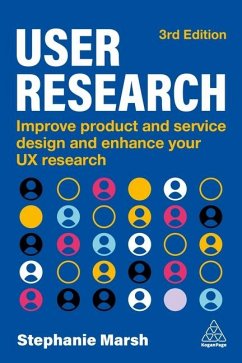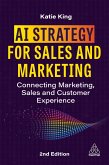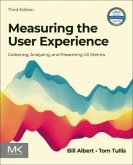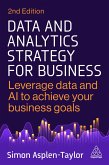- Broschiertes Buch
- Merkliste
- Auf die Merkliste
- Bewerten Bewerten
- Teilen
- Produkt teilen
- Produkterinnerung
- Produkterinnerung
Develop your market research skills with this straightforward guide to the best practices in user research methods. Utilize market research tools and methods effectively to obtain reliable results.
Andere Kunden interessierten sich auch für
![AI Strategy for Sales and Marketing AI Strategy for Sales and Marketing]() Katie KingAI Strategy for Sales and Marketing28,99 €
Katie KingAI Strategy for Sales and Marketing28,99 €![AI Strategy for Sales and Marketing AI Strategy for Sales and Marketing]() Katie KingAI Strategy for Sales and Marketing49,99 €
Katie KingAI Strategy for Sales and Marketing49,99 €![HBR Guide to Data Analytics Basics for Managers (HBR Guide Series) HBR Guide to Data Analytics Basics for Managers (HBR Guide Series)]() Harvard Business ReviewHBR Guide to Data Analytics Basics for Managers (HBR Guide Series)13,99 €
Harvard Business ReviewHBR Guide to Data Analytics Basics for Managers (HBR Guide Series)13,99 €![HBR Guide to Data Analytics Basics for Managers HBR Guide to Data Analytics Basics for Managers]() Harvard Business ReviewHBR Guide to Data Analytics Basics for Managers46,99 €
Harvard Business ReviewHBR Guide to Data Analytics Basics for Managers46,99 €![Market and User Research Operations Market and User Research Operations]() Stephanie MarshMarket and User Research Operations41,99 €
Stephanie MarshMarket and User Research Operations41,99 €![Measuring the User Experience Measuring the User Experience]() Bill Albert (Design Director and Bentley Univers Usability CenterMeasuring the User Experience42,99 €
Bill Albert (Design Director and Bentley Univers Usability CenterMeasuring the User Experience42,99 €![Data and Analytics Strategy for Business Data and Analytics Strategy for Business]() Simon Asplen-TaylorData and Analytics Strategy for Business28,99 €
Simon Asplen-TaylorData and Analytics Strategy for Business28,99 €-
-
-
Develop your market research skills with this straightforward guide to the best practices in user research methods. Utilize market research tools and methods effectively to obtain reliable results.
Produktdetails
- Produktdetails
- Verlag: Kogan Page Ltd
- 3 Revised edition
- Seitenzahl: 378
- Erscheinungstermin: 3. Dezember 2025
- Englisch
- Abmessung: 234mm x 156mm x 20mm
- Gewicht: 562g
- ISBN-13: 9781398625075
- ISBN-10: 1398625078
- Artikelnr.: 74173398
- Herstellerkennzeichnung
- Libri GmbH
- Europaallee 1
- 36244 Bad Hersfeld
- gpsr@libri.de
- Verlag: Kogan Page Ltd
- 3 Revised edition
- Seitenzahl: 378
- Erscheinungstermin: 3. Dezember 2025
- Englisch
- Abmessung: 234mm x 156mm x 20mm
- Gewicht: 562g
- ISBN-13: 9781398625075
- ISBN-10: 1398625078
- Artikelnr.: 74173398
- Herstellerkennzeichnung
- Libri GmbH
- Europaallee 1
- 36244 Bad Hersfeld
- gpsr@libri.de
Stephanie Marsh (she/they) is a leading expert in UX Research and UX Research Operations based in the UK. As the former Head of User Research and Analysis at the UK Government Digital Service and Head of Digital at the UK Ministry of Defence, they have played a pivotal role in advancing digital innovation within the public sector. Previously a Bunnyfoot consultant , one of the UK's leading UX consultancies, Stephanie has applied their expertise to enhance user experiences across diverse industries. As a respected thought leader, she has contributed to peer-reviewed publications and shared insights through speaking engagements at conferences and industry events.
Chapter
01: Introduction
why is user research so important?; Section
ONE: The fundamentals
what good research looks like; Chapter
02: Planning your user research; Chapter
03: Best practice in user research
what, why and how; Chapter
04: Managing user research for successful outcomes; Chapter
05: Getting the legal and ethical stuff right; Chapter
06: Cross
functional working; Section
TWO: Selecting and using user research methods; Chapter
07: Usability testing
observing people doing things; Chapter
08: User interviews
understanding people's experience through talking to them; Chapter
09: Surveys
how to gauge a widespread user response; Chapter
10: Getting the best out of stakeholder workshops
collaborative sessions for constructive work with key participants; Chapter
11: Content testing
what do people think your content means?; Chapter
12: Card sorting
understanding how people group and relate things; Chapter
13: Information architecture validation through tree testing
does the structure of your information work for your users?; Chapter
14: Diary studies
how to capture user research data over time; Chapter
15: Contextual inquiry
interviewing people in their own environment; Chapter
16: Ethnography and pop
up research
observing how people behave and running fast
paced research in the real world; Chapter
17: How to combine user research methodologies; Section
THREE: Analysing user research data and communicating the insights; Chapter
18: In
depth analysis
understanding your qualitative data; Chapter
19: Fast
paced analysis; Chapter
20: Analysing usability data and cataloguing issues and needs; Chapter
21: Making recommendations
how to make your research findings and insights actionable; Chapter
22: Creating impactful executive summaries and detailed reports to present results; Chapter
23: Tools for analysis and UX storytelling; Chapter
24: Conclusion;
01: Introduction
why is user research so important?; Section
ONE: The fundamentals
what good research looks like; Chapter
02: Planning your user research; Chapter
03: Best practice in user research
what, why and how; Chapter
04: Managing user research for successful outcomes; Chapter
05: Getting the legal and ethical stuff right; Chapter
06: Cross
functional working; Section
TWO: Selecting and using user research methods; Chapter
07: Usability testing
observing people doing things; Chapter
08: User interviews
understanding people's experience through talking to them; Chapter
09: Surveys
how to gauge a widespread user response; Chapter
10: Getting the best out of stakeholder workshops
collaborative sessions for constructive work with key participants; Chapter
11: Content testing
what do people think your content means?; Chapter
12: Card sorting
understanding how people group and relate things; Chapter
13: Information architecture validation through tree testing
does the structure of your information work for your users?; Chapter
14: Diary studies
how to capture user research data over time; Chapter
15: Contextual inquiry
interviewing people in their own environment; Chapter
16: Ethnography and pop
up research
observing how people behave and running fast
paced research in the real world; Chapter
17: How to combine user research methodologies; Section
THREE: Analysing user research data and communicating the insights; Chapter
18: In
depth analysis
understanding your qualitative data; Chapter
19: Fast
paced analysis; Chapter
20: Analysing usability data and cataloguing issues and needs; Chapter
21: Making recommendations
how to make your research findings and insights actionable; Chapter
22: Creating impactful executive summaries and detailed reports to present results; Chapter
23: Tools for analysis and UX storytelling; Chapter
24: Conclusion;
- Chapter - 01: Introduction: Why is user research so important?
- Section - ONE: The fundamentals: What good research looks like
- Chapter - 02: Planning your user research
- Chapter - 03: Best practice in user research: Who, what, why and how
- Chapter - 04: Getting the legal and ethical stuff right
- Chapter - 05: Setting up for success
- Chapter - 06: Managing user research logistics: agencies, facilities and contracts
- Section - TWO: Selecting and using user research methods
- Chapter - 07: Usability testing: observing people doing things
- Chapter - 08: Content testing: what do people think your content means?
- Chapter - 09: Card sorting: understanding how people group and relate things
- Chapter - 10: Surveys: how to gauge a widespread user response
- Chapter - 11: User interviews: understanding people's experience through talking to them
- Chapter - 12: Diary studies: how to capture user research data over time
- Chapter - 13: Information architecture validation through tree testing: does the structure of your information work for your users?
- Chapter - 14: Ethnography: Observing how people behave in the real world
- Chapter - 15: Contextual inquiry: Interviewing people in their own environment
- Chapter - 16: A/B Testing: A technique to compare different options
- Chapter - 17: Getting the best out of stakeholder workshops
- Chapter - 18: Guerrilla research: Running fast-paced research in the real world
- Chapter - 19: How to combine user research methodologies
- Section - THREE: Analyzing user research data
- Chapter - 20: Content analysis: understanding your qualitative data
- Chapter - 21: Identifying themes through affinity diagramming
- Chapter - 22: Thematic analysis: Going beyond initial analysis
- Chapter - 23: Agile analysis
- Chapter - 24: Analysing usability data and cataloguing issues and needs
- Chapter - 25: Analysing data to create personas to communicate user characteristics and behaviour
- Chapter - 26: Analysing data to create mental models: visualizing how users think and identify opportunities
- Chapter - 27: Turning findings into insights
- Section - FOUR: UX storytelling: Communicating your findings
- Chapter - 28: Making recommendations: How to make your research findings actionable
- Chapter - 29: Creating executive summaries and detailed reports to present results
- Chapter - 30: Using video playback to present your research results
- Chapter - 31: Using journey and experience maps to visualize user research data
- Chapter - 32: Using scenarios and storyboards to represent the user journey
- Chapter - 33: Using infographics to translate numerical and statistical data
- Chapter - 34: How to recommend changes to visual, interaction and information design
- Chapter - 35: Conclusion
Chapter
01: Introduction
why is user research so important?; Section
ONE: The fundamentals
what good research looks like; Chapter
02: Planning your user research; Chapter
03: Best practice in user research
what, why and how; Chapter
04: Managing user research for successful outcomes; Chapter
05: Getting the legal and ethical stuff right; Chapter
06: Cross
functional working; Section
TWO: Selecting and using user research methods; Chapter
07: Usability testing
observing people doing things; Chapter
08: User interviews
understanding people's experience through talking to them; Chapter
09: Surveys
how to gauge a widespread user response; Chapter
10: Getting the best out of stakeholder workshops
collaborative sessions for constructive work with key participants; Chapter
11: Content testing
what do people think your content means?; Chapter
12: Card sorting
understanding how people group and relate things; Chapter
13: Information architecture validation through tree testing
does the structure of your information work for your users?; Chapter
14: Diary studies
how to capture user research data over time; Chapter
15: Contextual inquiry
interviewing people in their own environment; Chapter
16: Ethnography and pop
up research
observing how people behave and running fast
paced research in the real world; Chapter
17: How to combine user research methodologies; Section
THREE: Analysing user research data and communicating the insights; Chapter
18: In
depth analysis
understanding your qualitative data; Chapter
19: Fast
paced analysis; Chapter
20: Analysing usability data and cataloguing issues and needs; Chapter
21: Making recommendations
how to make your research findings and insights actionable; Chapter
22: Creating impactful executive summaries and detailed reports to present results; Chapter
23: Tools for analysis and UX storytelling; Chapter
24: Conclusion;
01: Introduction
why is user research so important?; Section
ONE: The fundamentals
what good research looks like; Chapter
02: Planning your user research; Chapter
03: Best practice in user research
what, why and how; Chapter
04: Managing user research for successful outcomes; Chapter
05: Getting the legal and ethical stuff right; Chapter
06: Cross
functional working; Section
TWO: Selecting and using user research methods; Chapter
07: Usability testing
observing people doing things; Chapter
08: User interviews
understanding people's experience through talking to them; Chapter
09: Surveys
how to gauge a widespread user response; Chapter
10: Getting the best out of stakeholder workshops
collaborative sessions for constructive work with key participants; Chapter
11: Content testing
what do people think your content means?; Chapter
12: Card sorting
understanding how people group and relate things; Chapter
13: Information architecture validation through tree testing
does the structure of your information work for your users?; Chapter
14: Diary studies
how to capture user research data over time; Chapter
15: Contextual inquiry
interviewing people in their own environment; Chapter
16: Ethnography and pop
up research
observing how people behave and running fast
paced research in the real world; Chapter
17: How to combine user research methodologies; Section
THREE: Analysing user research data and communicating the insights; Chapter
18: In
depth analysis
understanding your qualitative data; Chapter
19: Fast
paced analysis; Chapter
20: Analysing usability data and cataloguing issues and needs; Chapter
21: Making recommendations
how to make your research findings and insights actionable; Chapter
22: Creating impactful executive summaries and detailed reports to present results; Chapter
23: Tools for analysis and UX storytelling; Chapter
24: Conclusion;
- Chapter - 01: Introduction: Why is user research so important?
- Section - ONE: The fundamentals: What good research looks like
- Chapter - 02: Planning your user research
- Chapter - 03: Best practice in user research: Who, what, why and how
- Chapter - 04: Getting the legal and ethical stuff right
- Chapter - 05: Setting up for success
- Chapter - 06: Managing user research logistics: agencies, facilities and contracts
- Section - TWO: Selecting and using user research methods
- Chapter - 07: Usability testing: observing people doing things
- Chapter - 08: Content testing: what do people think your content means?
- Chapter - 09: Card sorting: understanding how people group and relate things
- Chapter - 10: Surveys: how to gauge a widespread user response
- Chapter - 11: User interviews: understanding people's experience through talking to them
- Chapter - 12: Diary studies: how to capture user research data over time
- Chapter - 13: Information architecture validation through tree testing: does the structure of your information work for your users?
- Chapter - 14: Ethnography: Observing how people behave in the real world
- Chapter - 15: Contextual inquiry: Interviewing people in their own environment
- Chapter - 16: A/B Testing: A technique to compare different options
- Chapter - 17: Getting the best out of stakeholder workshops
- Chapter - 18: Guerrilla research: Running fast-paced research in the real world
- Chapter - 19: How to combine user research methodologies
- Section - THREE: Analyzing user research data
- Chapter - 20: Content analysis: understanding your qualitative data
- Chapter - 21: Identifying themes through affinity diagramming
- Chapter - 22: Thematic analysis: Going beyond initial analysis
- Chapter - 23: Agile analysis
- Chapter - 24: Analysing usability data and cataloguing issues and needs
- Chapter - 25: Analysing data to create personas to communicate user characteristics and behaviour
- Chapter - 26: Analysing data to create mental models: visualizing how users think and identify opportunities
- Chapter - 27: Turning findings into insights
- Section - FOUR: UX storytelling: Communicating your findings
- Chapter - 28: Making recommendations: How to make your research findings actionable
- Chapter - 29: Creating executive summaries and detailed reports to present results
- Chapter - 30: Using video playback to present your research results
- Chapter - 31: Using journey and experience maps to visualize user research data
- Chapter - 32: Using scenarios and storyboards to represent the user journey
- Chapter - 33: Using infographics to translate numerical and statistical data
- Chapter - 34: How to recommend changes to visual, interaction and information design
- Chapter - 35: Conclusion
"This book offers a comprehensive overview of how to be a great user researcher and explains exactly how to plan, run and debrief impactful user research. This new edition is right up to date with modern research needs for ethical data handling, and operationalising research. An essential handbook for new and experienced researchers to keep by their side!" Steve Bromley, Principal User Researcher at Reach PLC and author of Building User Research Teams and How To Be A Games User Researcher








